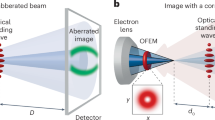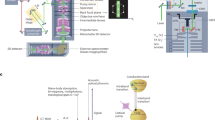Abstract
IT is now generally recognized that high-resolution dark-field electron microscopy is essential for a comprehensive study of inperfections in crystalline materials. However, commercial electron microscopes have not been designed in the past with this technique in mind, and consequently the amount of dark-field work that has been carried out to date is limited and has only been possible as a result of a considerable amount of perseverance on the part of the operator. Moreover, the operation has taken so long that injurious contamination of the specimen has occurred. A technique has now been developed here in co-operation with Associated Electrical Industries, Ltd., which allows a suitably modified E.M.6 electron microscope to be used with equal facility for high-resolution dark-field or light-field work.
This is a preview of subscription content, access via your institution
Access options
Subscribe to this journal
Receive 51 print issues and online access
$199.00 per year
only $3.90 per issue
Buy this article
- Purchase on SpringerLink
- Instant access to full article PDF
Prices may be subject to local taxes which are calculated during checkout
Similar content being viewed by others
References
Page, R. S. (unpublished).
Lucas, G. (to be published).
Ashby, M. F., and Brown, L. M., Phil. Mag., 8, 1083 (1963).
Hirsch, P. B., Howie, A., and Whelan, M. J., Phil. Trans. Roy. Soc., A, 252, 499 (1960).
Author information
Authors and Affiliations
Rights and permissions
About this article
Cite this article
HALE, K., MCLEAN, D. A New High-resolution Dark-field Electron Microscope Technique. Nature 201, 696 (1964). https://doi.org/10.1038/201696a0
Issue date:
DOI: https://doi.org/10.1038/201696a0
This article is cited by
-
Grain Size of Ausformed Steel
Nature (1965)



